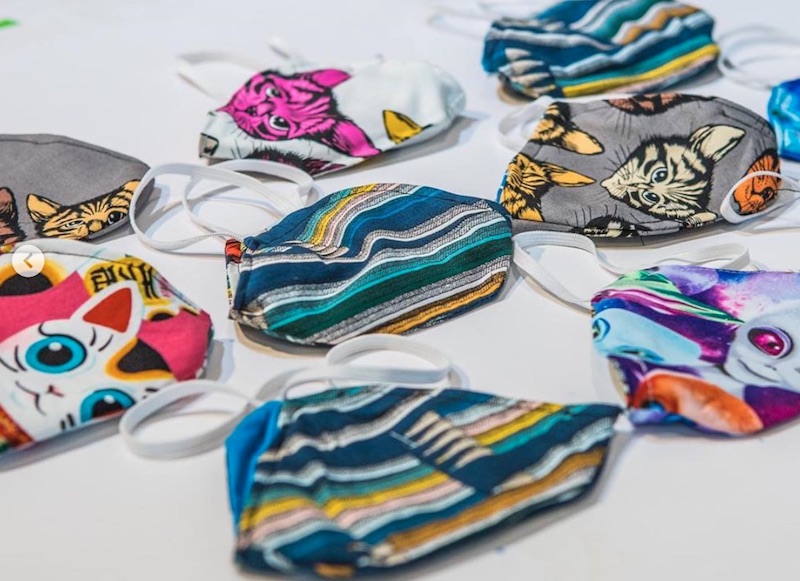
Starting Friday, all workers at essential businesses will have to wear a facial covering while on duty. All customers will have to don one, too, and may be refused service if they don’t.
While N95 masks are strictly reserved for medical workers, what constitutes as a good mask for the public? What’s the ideal material, design, and practice to protect ourselves and each other? To find out, we talked to Dr. Ben LaBrot, a USC clinical professor and the founder of nonprofit Floating Doctors. Here’s what we learned.
In brief, for the ideal facial covering, you should:
- Use thick, tightly-woven fabric
- Double layer
- Continue to practice social distancing
- Avoid touching your face
- Wash the mask when you get home and before wearing it again
But for more details, keep reading.
If I’m making my own mask, what should I use?
First of all, it’s important to remember that any facial covering is better than nothing. But, why settle when you could make or buy a great mask? The key here is thick, tightly-woven fabric, such as jersey cotton or quilting cotton. Avoid thin knits, like ski masks. This may mean sacrificing a nicer T-shirt over a cheaper one. You could also cut up a vacuum cleaner bag (studies indicate they’re pretty effective) or an air filter and sandwich that between cloth, provided it doesn’t contain fiberglass or other harmful materials.
Okay, I think I’ve picked a fabric. But how do I know if it’s suitable?
First of all, if you make a mask out of this fabric, will you be able to breathe comfortably when you go to the store? If you have to remove it frequently to gasp for breath, it’s too thick. Choose a different fabric instead.
To determine if your fabric is too thin, Dr. LaBrot says you can perform a light test by holding it up to the sun or a lamp.
“If you can see a lot of light coming through or if you can see the weave well, that’s less ideal than something that obscures light,” he says.
Additionally, if you know the thread count of your fabric, anything over 180 is preferred. Maybe you’ve got a spare pillowcase?
Okay, now what?
Make your mask. There are several tutorials online. The CDC has a few options here. This one is a video tutorial using fabric and two hair ties. But be sure to double your fabric up for an extra layer of protection. Here’s U.S. Surgeon General Jerome Adams folding up an old T-shirt and pairing it with two rubber bands.

Can I make my mask out of something else, like plastic, rubber, or maybe leather?
While these materials may look pretty sweet in Mad Max, they won’t help you in this pandemic. Your fabric mask works as a filter that catches the droplets other people expel when they breathe.
“If you use something like plastic or leather,” LaBrot says, “you’ll be sucking in air from around the mask. You want to breathe through, not around.”
These materials will at least protect other people from your droplets, but to be safe, it’s best to stick to cloth.
Okay, my mask is ready and I’m going to the store. What do I need to remember?
For one, don’t touch your face! A mask may prevent you from directly touching your mouth or nose, but the rest of your face is off-limits, too.
“You can mask up all you want, but if you rub contaminated hands in your eyes, you’re gonna get infected,” LaBrot says.
What if I can’t stop touching my eyes?
LaBrot suggests wearing a face shield, a mosquito net, or a veil for added protection. Which would be kind of cool, because you’d look like a mysterious bride.
Fine, I’ve stopped touching my face. What else?
LaBrot says the most important thing is, “don’t get cocky.” Keep washing and sanitizing your hands. Maintain social distancing. Wearing a mask is no reason to ease up, rub elbows, or socialize.
“No mask, no matter how good it is, is as effective as literally staying out of the reach of a virus,” LaBrot cautions.
I’m home from the store and I’m ready to de-mask and do one of the 51 online activities We Like LA suggested for this week. What should I do with my mask?
LaBrot points out that when a doctor or nurse removes an N95 mask, it’s considered a biohazard. Think of your used mask in the same way. Carefully remove it, don’t touch your face, and wash your hands. However, instead of tossing it out, you can wash your mask in your laundry machine or sink. Our cloth masks are more sustainable, environmentally and economically, that way.
What if I don’t want to wear a mask because I think it looks silly or just don’t like being told what to do?
With COVID-19, a single person could ultimately be the vector for so many others. Just because you don’t feel sick doesn’t mean you’re not infected. You could have yet to show symptoms or be asymptomatic. And your decision to not protect yourself and others could cost you or other people their lives. Think of wearing a mask as your civic duty.
“Essentially, not wearing a mask is the same thing as saying I don’t care if other people live or die,” LaBrot said.
And if you’re worried about how you look, think of this as an opportunity to be inventive instead.
“This is Angelenos’ chance to use what we’re so famous for—our creative innovation, ingenuity, fashion, fun, and our who-cares-what-other-people-think-attitude,” he said. “Take a mask and make it something cool and fun.”
You could also buy a fashionable facial covering from one of several Los Angeles apparel companies now pivoted to mask-making. The City of Los Angeles has a list of places to buy masks from here. The masks in our image above are available from Matrushka Construction. These handmade masks are $10 and contain three layers of cotton, plus a pocket for a filter.
We’re all going to be wearing masks, so make it fashion! If you do, you can use the hashtag #laprotects to share your design with others throughout the city who are doing the exact same thing.


